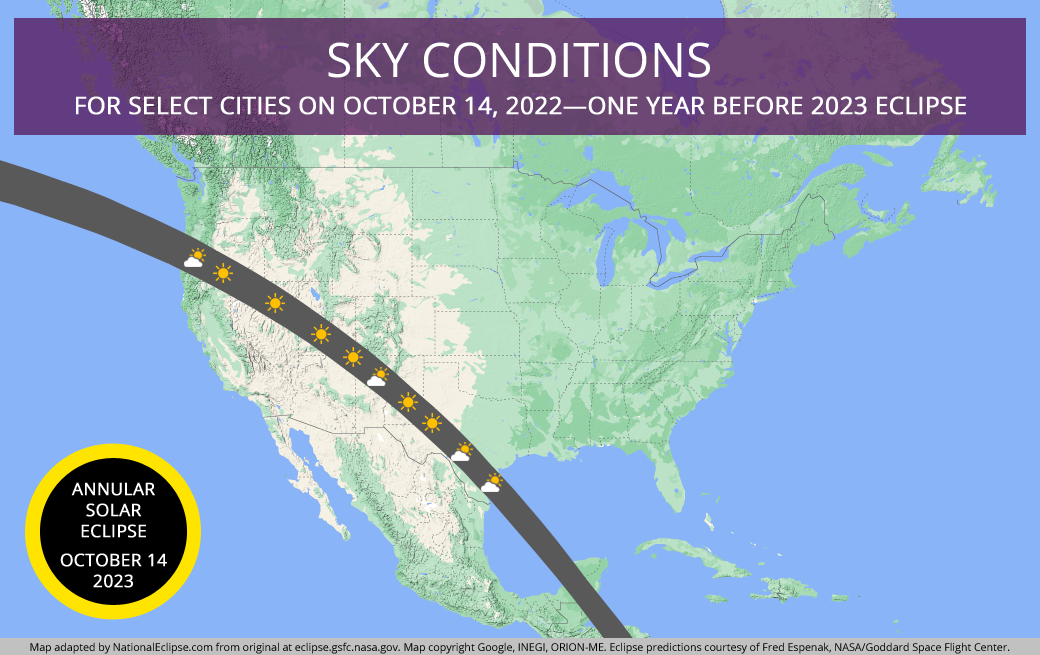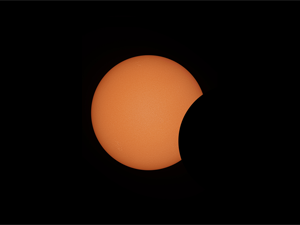(This is an archived page about the annular solar eclipse that occurred on October 14, 2023. For information on future eclipses, please see our Upcoming Eclipse Maps page.)
 What will the weather be like on October 14, 2023? That's the question everyone will be asking in the days leading up to the 2023 annular solar eclipse. Indeed, one of the most important factors to consider, both when planning an eclipse trip and in the days leading up to an eclipse, is the weather. A few stray clouds at the wrong moment can ruin months and even years of planning!
What will the weather be like on October 14, 2023? That's the question everyone will be asking in the days leading up to the 2023 annular solar eclipse. Indeed, one of the most important factors to consider, both when planning an eclipse trip and in the days leading up to an eclipse, is the weather. A few stray clouds at the wrong moment can ruin months and even years of planning!
During the historic 2017 total solar eclipse in America, much of the western U.S. enjoyed clear skies along the path of totality while clouds and even storms spoiled the view along the path in some parts of the central and eastern U.S. Some long-term projections were accurate while others missed the mark. As many people discovered, climate is not the same as weather and clouds can appear at any time, especially in higher elevations, so eclipse chasers need to remain mobile on eclipse day and be ready to move quickly to another location if clouds move in. In 2017, many people found clear skies just a short drive away from their original clouded-out locations!
Although NationalEclipse.com is not an eclipse weather forecasting site, below we provide some general information about what weather experts believe the weather might be like on eclipse day along the 2023 path of annularity in the U.S. We also include a chart showing what the weather was like in some of the large and noteworthy U.S. cities along the eclipse path on October 14, 2022—exactly one year before the 2023 annular solar eclipse. The information on this page should be used to generally evaluate weather prospects for October 14, 2023. Once you select a destination and arrive there, the most important thing you can do is monitor short-term weather forecasts for your viewing site in the days leading up to the eclipse and be prepared to move to another nearby location if necessary.
For the 2023 annular solar eclipse, weather experts believe that the weather odds for a successful eclipse viewing on October 14 along the path of annularity in the United States increase in favorability as you move south along the path from Oregon to New Mexico, where the best weather prospects can be found, and then reverse course and modestly decrease in favorability along the path in Texas. What follows is a state-by-state weather outlook, gleaned from a variety of sources, for each of the eight U.S. states along which the path of annularity will travel on October 14, 2023.
OREGON—The first state along the path of the 2023 eclipse is also the one with the highest probability of cloudy skies on October 14. When the eclipse commences on Saturday morning, Oregon's beaches will likely be a popular gathering spot within the 137-mile-wide path of annularity, but the maritime climate along the coast could produce morning clouds and fog that might obscure the view of the rising Sun. Better weather might be found farther inland in the valleys beyond the Coast Range, but even there morning fog might be a problem. If you decide to view the eclipse from Crater Lake National Park or anywhere else in the cloud-prone Cascades, make sure to check short-term weather forecasts in the days before the eclipse. Keep in mind, also, that it snows here in October. Beyond the Cascades, the likelihood of cloudy skies decreases dramatically as the path of annularity descends down into Oregon's high desert, which promises a relatively good possibility of favorable eclipse-watching weather.
CALIFORNIA—The weather outlook for the remote northeastern corner of California over which the path of annularity travels on October 14 is nearly identical to that in southern Oregon. Although there's not much to do in thinly populated Modoc County, the high desert landscape results in a relatively good chance of clear skies on eclipse day.
NEVADA—The weather odds continue to improve along the path of annularity in Nevada as the Moon's shadow crosses the vast topography of arid mountain ranges and valleys known as the Great Basin. The chances of precipitation will be low and the chances for sunny skies should be relatively high, especially in the valleys.
UTAH—In Utah, the increasing trend toward favorable weather prospects along the path of annularity continues as the eclipse track moves deeper into the dry ridge-and-valley terrain of the Great Basin. As in Nevada, the chances for rain or snow should be low and the chances for cloudless skies should be high. These odds can be increased even further by staying away from higher elevation areas. For the absolute best weather prospects for a successful eclipse viewing in Utah, head to the southeastern corner of the state, where the probability of clouds drops to the lowest point seen thus far along the eclipse track.
ARIZONA—The path of annularity only crosses over a small section of Arizona. But by the time it gets here, the transition has been made from the high desert of the Great Basin to the high desert of the Colorado Plateau. According to weather experts, this entire multi-state area of the American Southwest promises the best chances of clear skies along the path of annularity in the U.S.
COLORADO—Only a small triangle-shaped piece of Colorado—smaller even than Arizona's share—is captured inside the eclipse path. But in terms of weather, the outlook for fair skies along the path in Colorado is just as good as in Arizona and the rest of the Colorado Plateau.
NEW MEXICO—New Mexico, with its high desert landscapes, promises a great chance for cloud-free skies on eclipse day. In fact, eclipse weather forecasting site eclipsophile.com says the Colorado Plateau region of New Mexico, Arizona, and Colorado offers the "best eclipse-watching weather along the track." Since New Mexico encompasses most of that Colorado Plateau portion of the track, it's a good choice for those who want to combine favorable eclipse-viewing prospects with a lot of room to move around in the relatively unlikely event that clouds threaten.
TEXAS—The increasing trend of the possibility of cloud-free skies seen since Oregon reverses course in Texas. The probability of clouds never returns to Oregon-like levels, but the possibility of cloudy skies on October 14 does steadily increase along the path of annularity here in Texas. Essentially, the closer you get to the coast, the more exposure to moisture from the Gulf of Mexico. Make sure to check short-term weather forecasts for the chance of clouds and fog, especially along the Texas shore, during the late-morning hours. Thunderstorms and tropical storms are still possible in Texas in mid-October, but less frequent than earlier in the year.
TOP| City | Low* | High* | Annularity Start | Duration* | Sky* |
|---|---|---|---|---|---|
| Eugene, OR | 41° F | 82° F | 9:16:57 AM PDT | 3:55 | Sun & Clouds |
| Klamath Falls, OR | 39° F | 88° F | 9:17:58 AM PDT | 3:23 | Sun |
| Elko, NV | 32° F | 79° F | 9:22:30 AM PDT | 4:18 | Sun |
| Richfield, UT | 37° F | 73° F | 10:26:27 AM MDT | 4:37 | Sun |
| Cortez, CO | 34° F | 70° F | 10:31:41 AM MDT | 3:04 | Sun |
| Albuquerque, NM | 48° F | 75° F | 10:34:34 AM MDT | 4:50 | Sun & Clouds |
| Santa Fe, NM | 39° F | 72° F | 10:36:03 AM MDT | 2:48 | Sun |
| Roswell, NM | 52° F | 79° F | 10:38:47 AM MDT | 4:42 | Sun |
| Odessa, TX | 52° F | 82° F | 11:43:13 AM CDT | 4:49 | Sun |
| Midland, TX | 52° F | 84° F | 11:43:25 AM CDT | 4:55 | Sun |
| San Antonio, TX | 70° F | 90° F | 11:52:08 AM CDT | 4:21 | Sun & Clouds |
| Corpus Christi, TX | 75° F | 90° F | 11:55:48 AM CDT | 5:02 | Sun & Clouds |
Eclipse data courtesy of Fred Espenak, NASA/Goddard Space Flight Center, from eclipse.gsfc.nasa.gov. Note that times and durations can vary widely even within the same city and some cities are located only partially within the path of annularity. All times and durations shown on this page are only representative samples and should be used for general comparison purposes only.
* "Low" and "High" are the daily lows and highs; "Duration" refers to the duration of annularity and is expressed in minutes and seconds; "Sky" refers to the general sky conditions that were observed on October 14, 2022, at or near the time of day that annularity will occur locally during the 2023 eclipse
TOP
The following map shows the general sky conditions that were observed on October 14, 2022—exactly one year before the 2023 annular solar eclipse—for select cities along the 2023 path of annularity at or near the time of day that annularity will occur locally during the 2023 eclipse. Please note that this map should only be used to see what might be possible on October 14, 2023, and is not a forecast.

If you arrived on this page looking for information on what kinds of effects a solar eclipse has on the weather, rather than information on eclipse-day weather itself, that's what this section is for. A solar eclipse can indeed have some noticeable effects on the current weather—some subtle and others much more obvious.
 You will probably notice a temperature drop during a solar eclipse. Usually, you can expect about a ten degree (F) drop in temperature during the progression of a total solar eclipse, although drops of even 20 degrees or more have been reported. Logically, the more the Sun is obscured, the more the temperature should drop, although relatively large drops have been reported for some partial solar eclipses (the NationalEclipse.com History page includes a digitized newspaper article from 1834 that, if it can be believed, reports an incredible 28 degree drop in temperature for an 88 percent partial eclipse!)
You will probably notice a temperature drop during a solar eclipse. Usually, you can expect about a ten degree (F) drop in temperature during the progression of a total solar eclipse, although drops of even 20 degrees or more have been reported. Logically, the more the Sun is obscured, the more the temperature should drop, although relatively large drops have been reported for some partial solar eclipses (the NationalEclipse.com History page includes a digitized newspaper article from 1834 that, if it can be believed, reports an incredible 28 degree drop in temperature for an 88 percent partial eclipse!)
A drop in temperature during a solar eclipse can cause another eclipse weather effect—one that could possibly aid eclipse viewers. Although it should never be counted on to guarantee clear skies, a temperature drop might help to dissipate a buildup of heat-driven cumulus clouds that might otherwise get in the way of a successful viewing.
The temperature drives many aspects of the weather and the temperature drop that occurs during a solar eclipse can also have an effect on the wind. As the ground cools due to a decrease in solar radiation, the breeze might die down or even change direction. This happens because warm air stops rising from the cooled-off ground. In fact, this is why hot air balloons usually only launch in the morning or the evening when the ground is cooler and the atmosphere in more stable.
Finally, although not a weather effect, per se, some observers have noticed a strange visual phenomenon on the ground during a total solar eclipse called "shadow bands." Occurring shortly before and after totality, shadow bands manifest as rippling patterns of light and shadow reminiscent of what you might see on the bottom of a pool on a sunny day. Although there's still some debate over what actually causes this, the generally accepted hypothesis is that shadow bands are caused by turbulence in the Earth's atmosphere that refracts the light coming from the narrow solar crescent.
TOP